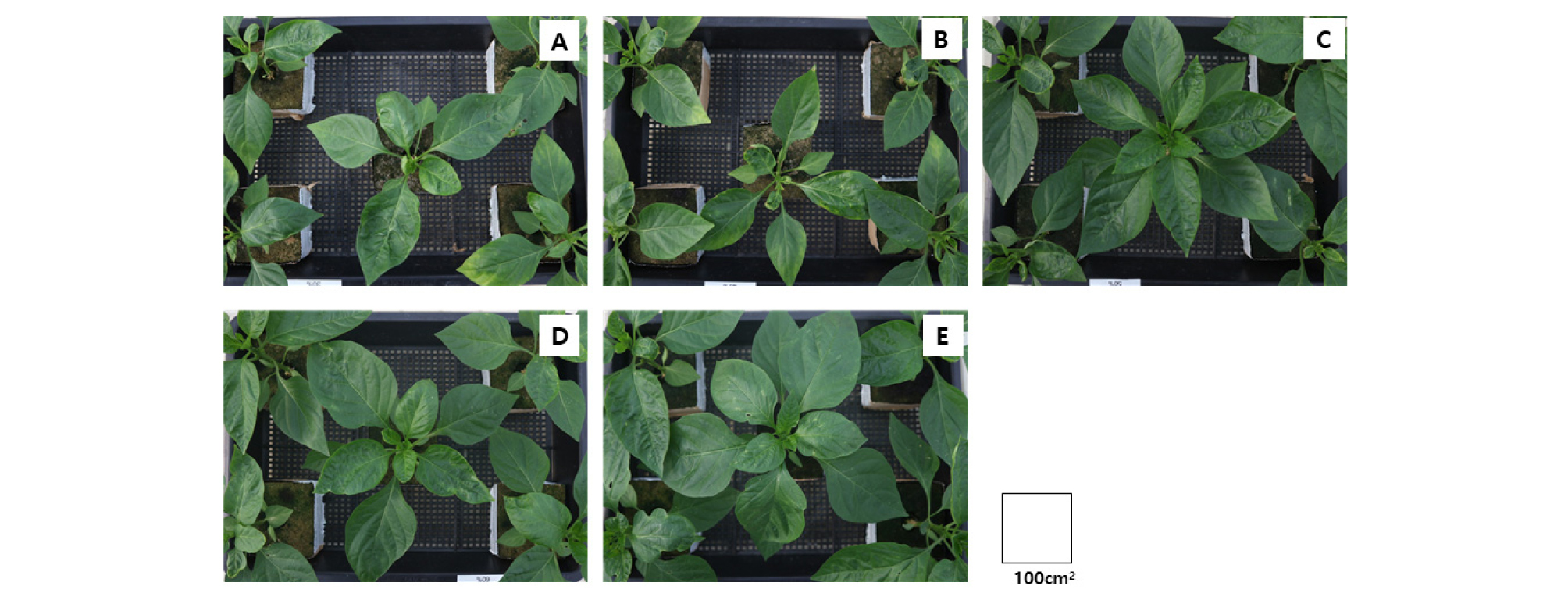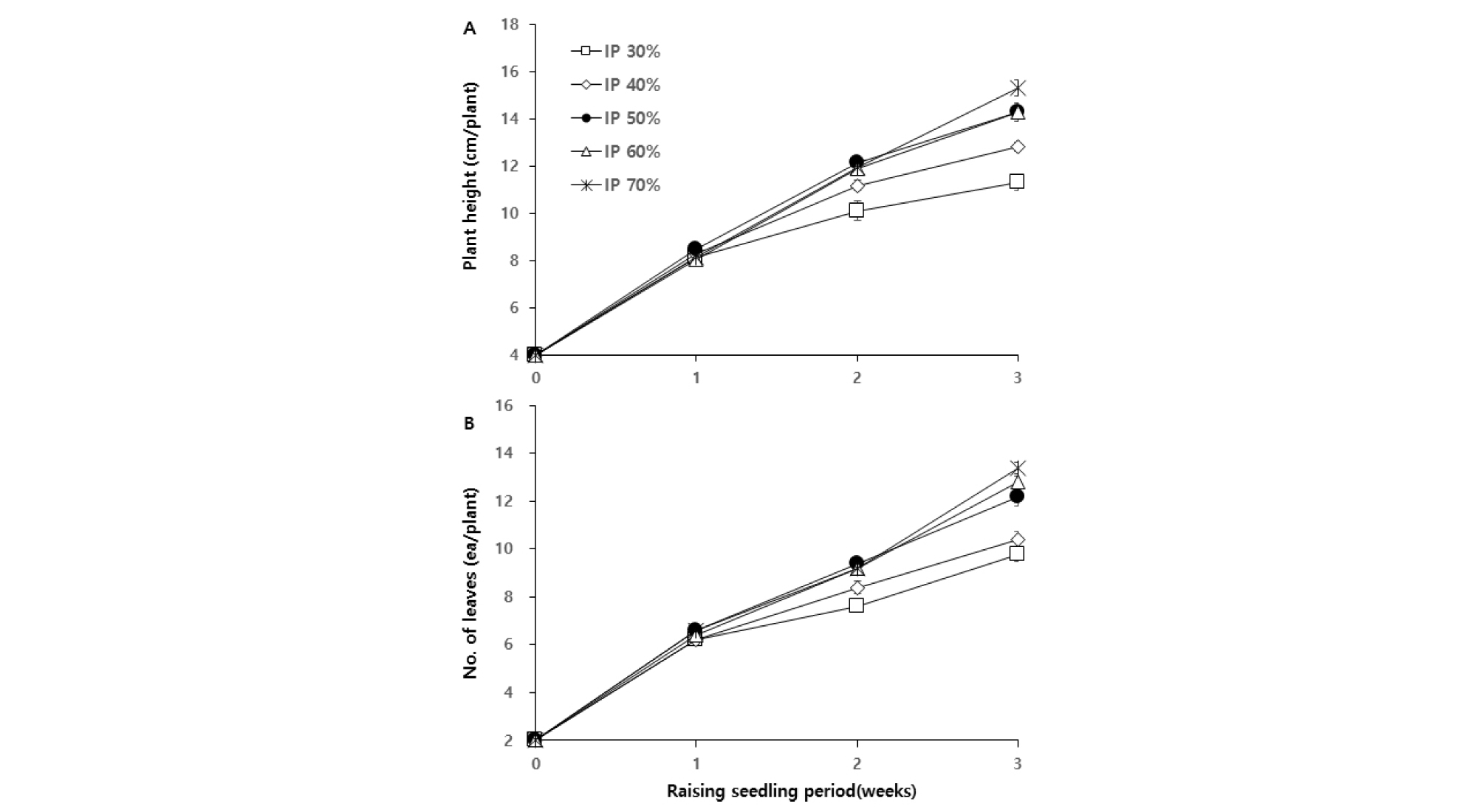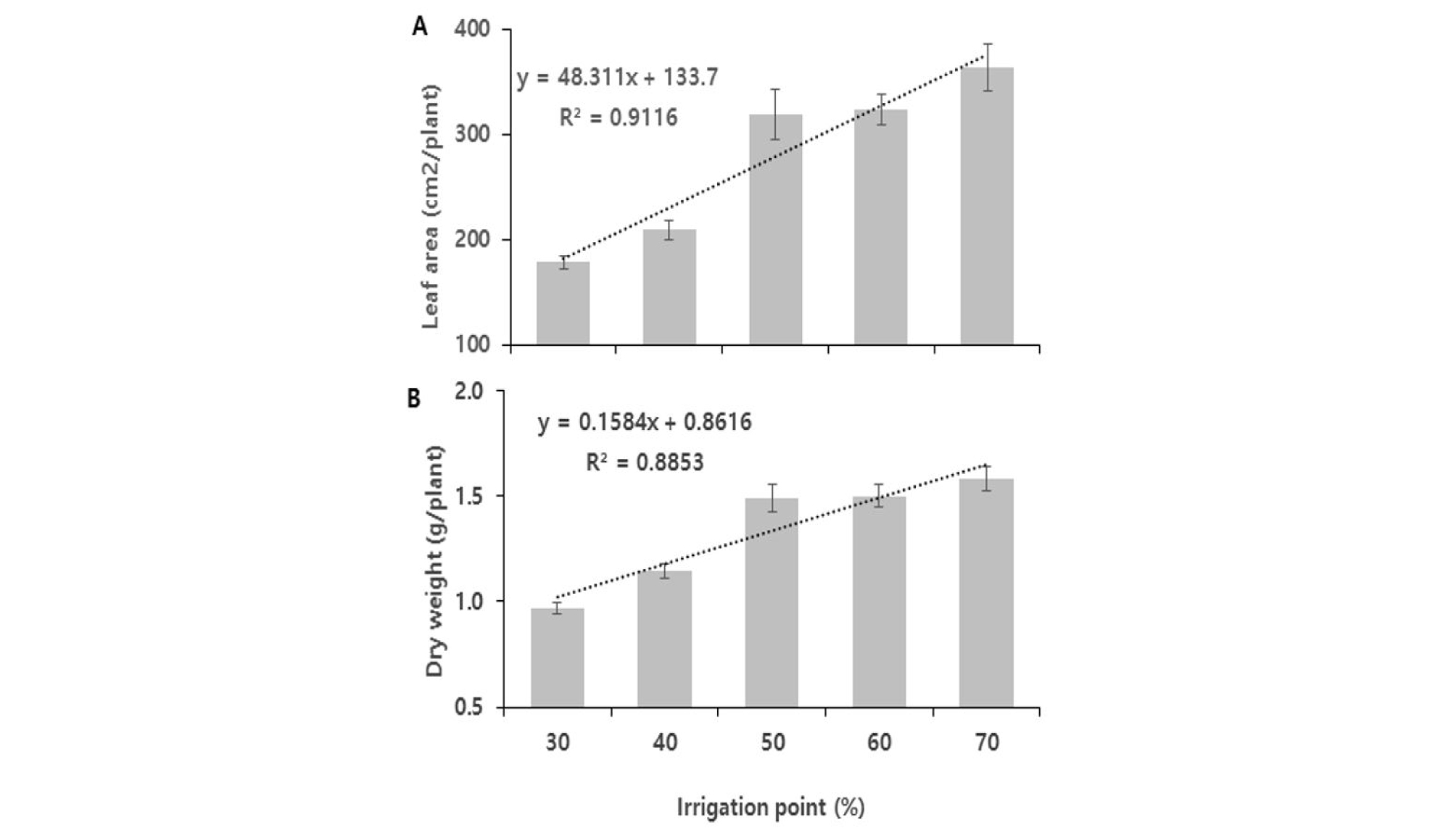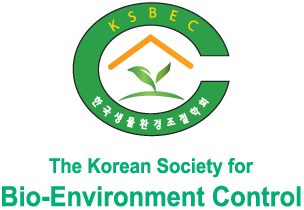서 론
재료 및 방법
1. 급액시점에 따른 파프리카 묘 관리
2. 급액시점에 따른 파프리카 묘의 생육특성 조사
3. 통계 처리
결과 및 고찰
1. 암면블록의 급액시점에 따른 파프리카 묘의 소질
2. 암면블록의 급액시점에 따른 관수체계 차이
서 론
국내에서는 시설재배의 확산과 더불어 1990년대 이후 공정육묘의 발달로 자가육묘에서 플러그(Plug) 육묘 방식으로 전환되었다(Shin, 1997). 공정육묘는 자가육묘에 비해 연중 및 대량생산, 노동력절감, 균일한 묘 생산, 수확량 증대, 병해충 관리 등에서 장점을 가지고 있다(Lee 등, 2013; Kim 등, 2015; Shin, 2000). 묘 소질은 정식 후 생산성 및 품질에 큰 영향을 미치는 중요한 요인으로(Buwalda 등, 2006), 묘의 생육 조절을 통해 품질을 높이고자 광 환경(Kang 등, 2010; Lee 등, 2012; Um 등, 2009), 물리적 자극(Choi 등, 2001), 주·야간 온도차(Kim 등, 1999a; Kim 등, 2013b), triazole계 농약을 이용한 생장조정제(Jo, 2015; Zhang 등, 2003), 플러그 셀 크기(Lee 등, 2001), 육묘 일수 및 온도(Jo 등, 2016; Kim 등, 1999b; Kim 등, 2015), 관수관리법(Lee와 suh, 2009) 등 다양한 연구들이 진행되었다. 하지만 대부분의 연구들은 플러그 묘에 집중되었고, 암면 큐브를 이용한 저면관수 방식인 파프리카 육묘는 아직까지 자가육묘에 의존하고 있어 재배기술 대비 육묘기술 수준이 낮은 실정이다. 토양재배에 비해 수경재배용 배지들은 그 용량에서 제한되어 있고 이로 인하여 보수력이 낮아 적절한 관수관리가 필수적이다(Pauwels와 samson, 2006). 파프리카, 토마토, 고추 등의 수분 관리는 작물의 생체중, 건물중에 영향을 주며 배지수분함량을 너무 낮거나 높게 유지하면 건조 또는 과습에 의한 스트레스가 발생한다고 보고되었다(Jang 등, 2014; An 등, 2009). 또한 배지 종류에 따라 적정 수분 함량이 다르며 수분 보유 함량을 높게 유지할 시 배꼽썩음과와 공동과 발생 빈도가 증가한다고 보고되었다(Lee 등, 2009). 이와 같이 수경재배에서 배지의 수분관리는 작물의 생육에 중요한 요인으로 작용한다(Narn 등, 2005). 파프리카 육묘는 파종판에서 발아 후 암면 큐브에 이식하여 양성된 후 재배온실의 슬라브(slab) 배지에 정식되는 과정을 거친다. 암면 큐브에 이식한 후 수분관리는 양액 공급 후 묘를 포함한 암면 큐브의 무게를 제어하여 양성한다. 현장에서는 관행적으로 암면큐브에 100% 양액이 흡수된 이후 그 무게의 50-60%가 될 때 재공급을 하는 방법을 이용하고 있다. 하지만 그 제어가 명확하게 이루어지지 못하고 있고 생장량의 변화를 고려하지 못하고 있어 동일한 조건의 농가 간에도 묘 소질의 차이를 나타내고 있다.
따라서 본 연구는 정밀한 무게 제어가 가능한 로드셀방식 자동급액시스템을 이용하여 파프리카 육묘 시 적정 급액시점을 검증하고자 수행되었다.
재료 및 방법
1. 급액시점에 따른 파프리카 묘 관리
2019년 7월에 원광대학교 원예산업학부 실습 포장 내에서 파프리카 ‘아시아레드(Asiaseed Co., Korea)’를 대상으로 저면관수방식의 육묘 시 급액시점에 따른 생육 차이를 조사하였다. 240공 암면플러그(UR media Co., Korea)를 이용하여 파종한 후 생장상에서 25±1℃, 상대습도 90%로 7일 정도 관리하여 발아시킨 후 자연광 상태로 옮겨주었다. 이후 본엽이 2매 전개되었을 때, 처리구 당 10주씩 암면큐브(10× 10×6.5cm, UR media Co., Korea)에 U자형으로 절곡하여 이식하였다(An 등, 2002). 암면블록 이식 후 플라스틱 필름 하우스 내 Ebb & Flow 생육상에서 3주간 양성하였다. 급액시점 설정은 수분함량 100%인 암면 큐브 무게(520g)의 30, 40, 50, 60 및 70%로 하였고, 농촌진흥청에서 제시한 파프리카 표준 배양액(pH 5.8, EC 1.8dS·m-1)을 저면관수 방식으로 공급하였다. 재배농가의 조건과 동일하게 하기 위하여 플라스틱필름 온실에서 온도제어를 하지 않고 시험을 수행하였다. 시험 기간 동안 일 평균 온도는 32.9℃, 일 평균 일사량은 377W∙m-2이었다.
2. 급액시점에 따른 파프리카 묘의 생육특성 조사
암면큐브 이식 후부터 매주 초장과 엽수를 조사하였고 육묘 종료 후 파괴 조사를 실시하였다. 파괴 조사는 지제부를 절단 후 지상부의 초장, 경경, 엽수, 엽면적, 생체중 및 건물중, 그리고 이들을 이용하여 건물률, 상대생장률, 엽면적률, 순동화율을 조사하였다. 초장은 30cm 자를 이용하여 생장점까지의 길이를 측정하였고, 경경은 지제부의 1cm 위를 캘리퍼스(500-182, Mitutoyo Co., Kawasaki, Japan)를 이용하여 측정하였다. 엽수는 줄기로부터 분리하여 세었고, 엽면적은 엽면적측정기(LI-3100, LI-COR Co., Lincoln, USA)를 이용하여 측정하였다. 묘의 생체중 및 건물중은 미량전자저울(HS-210TT, Hansung co., Korea)을 이용하여 측정하였는데, 생체중 측정 후 60℃ 건조실에서 96시간정도 완전히 건조시킨 후 건물중을 측정하였다.
묘의 생장분석을 위해 암면큐브 이식 전 묘와 육묘가 종료된 묘의 파괴조사 된 결과들을 이용하여 상대생장률, 엽면적률, 순동화율, 건물률을 농촌진흥청 농업과학기술 연구조사 분석기준(RDA, 2012)에 따라 아래와 같이 계산하였다.
-상대생장률(RGR, Relative growth rate) = (Loge DW2 – Loge DW1) ÷ (T2-T1)
-순동화율(NAR, Net assimilate rate) = {(DW2 - DW1) × (Loge DW2 – Loge DW1)} ÷ {(T2-T1) × (L2-L1)} × D
-엽면적률(LAR, Leaf area rate) = L ÷ DW
-건물률(Dry mass) = (DW ÷ FW) × 100
‧L (Leaf area) : 식물체당 엽면적 (cm2/plant)
‧DW (Dry weight) : 식물체당 건물 중량 (g/plant)
‧FW (Fresh weight) : 식물체당 생체 중량 (g/plant)
‧DW1, DW2 : 시작과 종료 시점의 식물체 건물 중량 (g/plant)
‧T1, T2 : 시작과 종료 시점의 시간 (days)
‧L1, L2 : 시작과 종료 시점의 식물체 엽면적 (cm2/plant)
‧D (Density) : 육묘 베드 내 묘의 밀도
3. 통계 처리
측정된 데이터는 SPSS 통계프로그램(12.0 Version, IBM Co., USA)과 엑셀 소프트웨어(MS OFFICE 2016, Microsoft Co., USA)를 사용하여 분석되었다. 처리 간 유의차 검증은 95% 신뢰수준에서 Duncan 다중 검정(Duncan’s multiple range test)를 이용하여 분석하였다.
결과 및 고찰
1. 암면블록의 급액시점에 따른 파프리카 묘의 소질
급액시점(Irrigation Point, IP)에 따라 양성 된 파프리카 묘의 생육 특성을 살펴보면(Table 1), 급액시점과 생육량 간 정의 상관성을 나타내는 경향이었다. 특히 IP 50% 이상과 나머지 처리구 간 생육 차이가 뚜렷하게 나타났다. 초장은 IP 30%에서 11.3cm, IP 40%에서 12.8cm, IP 50%에서 14.3cm, IP 60%에서 14.3cm, IP 70%에서 15.3cm를 나타내어 수분함량을 높게 유지할수록 긴 경향이었다(Fig. 1). 경경은 IP 50% 이상에서 4.96~5.02mm로 유의한 차이를 나타내지 않았지만 IP 30% 와 IP 40%에서는 각각 4.14mm, 4.51mm로 수분함량을 낮게 유지할수록 유의하게 얇았다. 엽수는 IP 70%, IP 50~60%, IP 30~40%에서 각각 13.4매, 12.2~12.8매, 9.8~10.4매로 암면큐브의 수분을 높게 유지할수록 유의하게 많았다. 엽면적은 IP 30%에서 179cm2/plant, IP 40%에서 209cm2/ plant, IP 50%에서 319cm2/plant, IP 60%에서 323cm2/plant, IP 70%에서 363cm2/plant를 나타내어 암면큐브의 수분함량이 높게 유지될수록 넓어지는 경향이었다(Fig. 2). IP 40% 이하에서 IP 50% 이상에 비해 생육량이 뚜렷하게 낮았던 것은 급액시점까지 수분함량이 낮아지면서 일시적인 수분스트레스를 반복적으로 받았기 때문으로 생각된다(Kwack 등, 2014). 지속적인 수분스트레스는 세포조직의 파괴를 유발하기도 하는 것으로 알려져 있다(Lee 등, 2015).
Table 1.
Growth characteristics of paprika seedlings grown under various irrigation point for 3 weeks after transplanting into rockwool cube.
급액시점에 따른 파프리카 묘의 생체중과 건물중을 살펴보면(Table 2), 생체중은 IP 50~70%에서 유의한 차이를 나타내지 않았으며 IP 40% 및 30%에서는 뚜렷하게 가벼운 경향이었고, 건물중도 생체중과 동일한 경향이었다. 하지만 건물률은 IP 30~40% 처리구에서 11.5~11.6%로 IP 50~70%의 10.5~10.6% 보다 유의하게 높았다. 이와 같이 결과는 암면큐브의 수분을 높게 유지할수록 암면큐브 내에 지속적인 높은 양액 잔류에 의하여 양‧수분의 확보가 잘 이루어지고 수분의 공급이 원활하게 이루어져 식물체의 수분 비율이 높았기 때문으로 생각된다. 하지만 지속적인 과습은 병해 발병 확률과 이로 인한 관리의 노동력이 증가할 수 있다고 보고되기도 하였다(Kang와 Kim, 2017).
Table 2.
Fresh weight, dry weight, dry mass of paprika seedlings grown under various irrigation point for 3 weeks after transplanting into rockwool cube.
급액시점에 따른 파프리카 묘의 초장과 엽수 변화를 보면(Fig. 3), 초장과 엽수는 이식 후 1주 구간까지는 처리 간 유의한 차이를 나타내지 않았다. 하지만 이식 후 1주에서 2주 구간에서 유의한 차이가 나타나기 시작했고, 2주에서 3주 구간에서 이러한 경향이 더욱 뚜렷했다. 초장의 생육이 이식 후 1주간 유의한 차이가 나타나지 않았던 것은 이식 후 초기에 뿌리부가 암면큐브에 완전히 활착되지 않아 실제 흡수하는 양수분의 차이가 적었기 때문으로 판단된다. 이후 뿌리가 암면큐브에 활착되어 급액 시점 차이에 따라 유지되는 암면큐브 내 양‧수분 흡수 차이가 생육에 영향을 미치기 시작한 것으로 생각된다. 따라서 암면큐브 이식 직후보다는 지하부의 활착이 시작되는 시기부터 세밀한 급액 관리가 필요할 것으로 생각된다.
급액시점에 따라 3주 동안 양성된 파프리카 묘의 상대생장률, 순동화율, 엽면적률을 조사하였다(Table 3). 상대생장률은 암면블록의 수분함량이 높을수록 증가하는 경향이었다. 특히, 수분스트레스로 생육 저하가 발생한 것으로 생각되는 IP 30%와 40%에서는 0.1~0.2 정도 뚜렷하게 낮았다. 상대생장률이 낮았던 IP 30%와 40%에서 단위 엽면적 당 건물 생산을 나타내는 순동화율이 높았던 것은 엽면적률이 낮았기 때문이다. 전반적으로 상대생장률과 엽면적률이 정의상관을 나타내었으며 이에 따라 순동화율은 반대의 경향을 나타내었다. 이는 단위 엽면적 당 건물생산 효율이 높았던 것 보다는 암면큐브의 수분함량에 따라 양‧수분의 공급이 원활하여 식물체의 수분 비중이 높았기 때문으로 생각된다.
Table 3.
Relative growth rate (RGR), net assimilation rate (NAR), leaf area ratio (LAR) of paprika seedlings grown under various irrigation point.
급액시점에 따라 3주 동안 육묘된 파프리카 묘의 엽면적, 건물중 변화의 관계를 회귀분석한 결과(Fig. 4), 급액시점(x)과 엽면적(Y1) 간 Y1 = 48.331x + 133.7 (R2 = 0.9116**)의 선형회귀관계를 나타내었고, 건물중(Y2)과는 Y2 = 0.1584x + 0.8616 (R2 = 0.8853**)의 관계를 유의하게 나타내었다.
2. 암면블록의 급액시점에 따른 관수체계 차이
급액시점(irrigation point, IP)에 따른 파프리카 묘의 생산에 대한 관수 공급 체계를 살펴보면(Table 4), 3주 동안 총 급액횟수는 IP 30%에서 3회, IP 40%에서 3회, IP 50%에서 5회, IP 60%에서 5회, IP 70%에서 7회 공급되었다. 1회 공급 시 평균 수분유지 기간은 IP에 따라 각각 6.3, 5.7, 4.0, 3.6 및 3.0일이었다. 급액횟수나 1회 급액 후 수분유지 기간에서 IP 30%와 70% 간에는 2배 이상의 차이를 나타내었다.
Table 4.
Irrigation levels supplied for producing paprika seedlings for 3 weeks under various irrigation point in rockwool cube.
| Irrigation point (%) | Total irrigation number | Average of water maintenance periodz (days) |
| 30 | 3 | 6.3 |
| 40 | 3 | 5.7 |
| 50 | 5 | 4.0 |
| 60 | 5 | 3.6 |
| 70 | 7 | 3.0 |
급액횟수별 암면블록의 수분유지 시간의 변화를 살펴보면(Fig. 5), 첫 번째 급액 시 IP 30%에서 12일, IP 40%에서 10일, IP 50%에서 9일, IP 60%에서 8일, IP 70%에서 5일간 유지되었다. 두 번째 급액 시 IP 70%에서 5일간 유지되어 4일간 유지된 IP 50~60%에 비해 오히려 길었다. 이는 첫 급액 후 IP 70%에서는 수분 과다 조건이 되어 IP 50~60%에 비해 늦은 뿌리 활착 및 지상부 생장으로 수분 소비량이 일시적으로 줄었기 때문으로 판단된다. 4회 이상 급액된 IP 50~70%에서는 3~4회차 급액 시 2~4일 정도 유지되었고, 7회 급액된 IP 70%에서는 5~6회차 급액 시 2일 정도 유지되었다. 시간이 경과할수록 동일 처리에서 수분 유지 기간이 짧아지는 것은 묘의 지속적인 생장에 따라 요구되는 수분과 증산량이 증가하였기 때문으로 판단된다.









